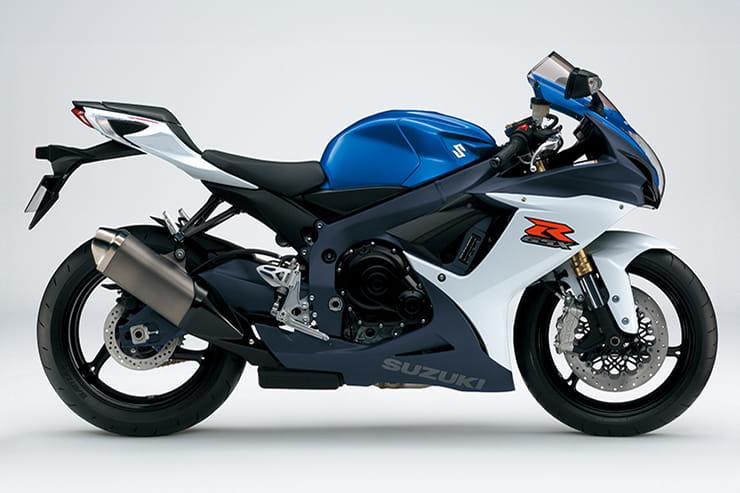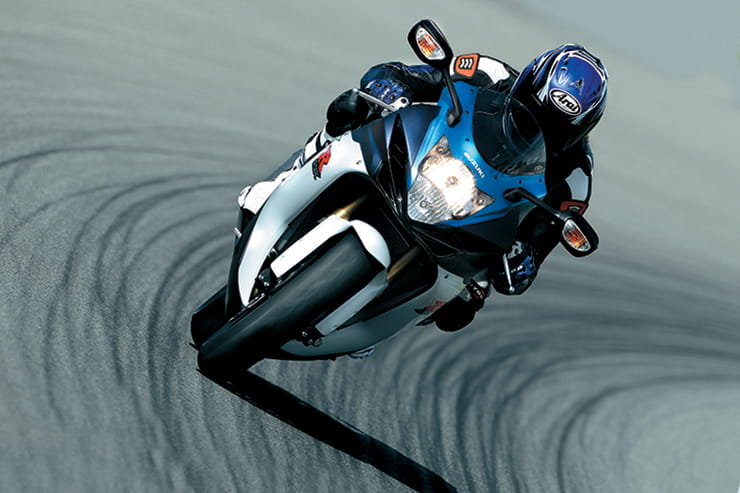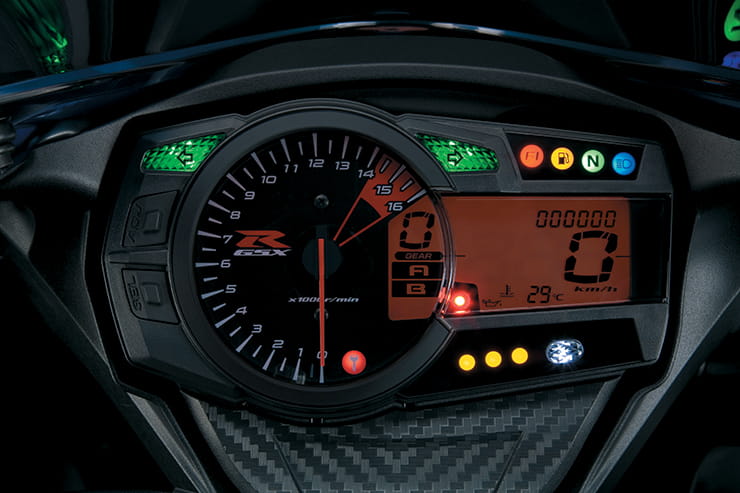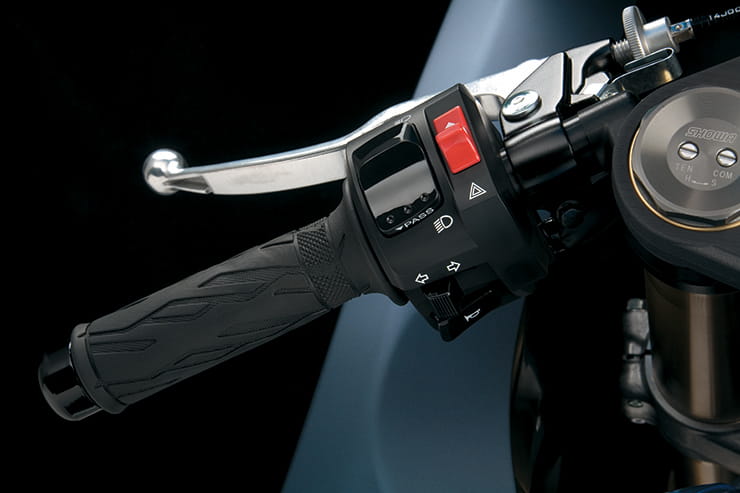Price: £5000-£8500 | Power: 150bhp | Weight: 190kg | Overall BikeSocial Rating: 5/5
All good things eventually have to come to an end and in 2011 Suzuki released the final version of their ground-breaking GSX-R750 model range. Having clung on in a defunct class while all around jumped ship, Suzuki stubbornly kept making their three-quarter litre sportsbike and in 2011 it received its last update. But what a bike. Arguably the finest example of this sublime machine, the 2011 GSX-R750 is a wonderful sportsbike which demonstrates that in a world dominated by headline power figures, if you really just want a machine to ride and enjoy it is much better to go for something with a little less power, virtually no electronics and a chassis that is usually found on a supersport bike. A true ‘rider’s bike’ that allows you to use and improve your riding skills rather than rely on electronics to make you look good, this final generation of Suzuki GSX-R750 is quite simply brilliant. What a bike.
Suzuki GSX-R750 (2011-2018) Price
Back in 2011 the GSX-R750 cost under £10,000 at £9899, which certainly made it seem appealing as the latest breed of ‘digital’ litre sportsbikes started at £13,000 (aside from the aging GSX-R1000...) and went up to £20,000 for the top-spec models. However it has to be noted the Triumph Daytona 675R was the same price as the GSX-R and it came with Öhlins bling that the Suzuki lacked... Did the GSX-R sell for £9899? Not really, most were discounted and by the time it went off sale in 2017 (there are a fair few 2018 registered models as they hung about in dealerships) it realistically sold for a lot less as riders were drawn to the tech-heavy litre bikes instead. Even the MotoGP rep, which had an RRP of £10,699, didn’t sell for its full price tag.
Nowadays you can get a 2011 GSX-R750 for £4000 if you are happy to see a bit of wear and tear and a big mileage (for a sportsbike, so over 30,000...) but realistically spending £5000 - £5500 is a better idea as that will get you a good one with less than 15,000 miles on its clocks. As the GSX-R was never updated there is no need to buy a later model unless you just want an example that is a bit newer and fresher, in which case the top end for a real beauty with under 10,000 miles on its clocks is £8000-£8500.
Pros & Cons
- Amazing confidence-inspiring chassis
- Perfect balance of power and handling for road riding
- It’s a GSX-R750!
- It does lack electronics
- The look is a bit bland
- The brakes could be better, especially on track
Engine and Performance
Suzuki didn’t really shout about the improvements they made to the GSX-R750’s inline four but when you ride a 2011 model it is an incredibly impressive motor. With altered valve angles, improved efficiency and a more compact combustion chamber, not to mention lighter titanium valves, it all adds up to a wonderfully useable motor that is incredibly engaging and fun to ride without ever feeling like it is too much of a handful. But don’t think that all means it is slow – far from it...
With a claimed 150bhp the Suzuki has more than enough top-end performance (it can hit 170mph if required) but it is its 64.1lb-ft of torque and the associated drivability that when combined with a glorious throttle response is what makes the GSX-R so special. On a twisty road you never feel short-changed by the Suzuki’s performance and instead it just seems to be working with you rather than trying to scare you silly. Ride it in the mid-range and it is relaxed and assured and should you want a bit more of a thrill – well, it’s a GSX-R so that means allow it to rev to over 8000rpm and it snarls through its induction and chases after the redline with real enthusiasm. It’s a great engine and one that reminds you that while 200bhp is all very well and good, the fact modern sportsbikes need electronics to neuter their power does make you wonder if that is an admission that they actually have a bit too much of the good stuff for road riding...
When it comes to buying used, the GSX-R’s engine is pleasingly reliable and most issues are simply down to a lack of servicing or use. Unless the bike is ridden regularly the exhaust valve can seize up, so look for a fault code on the dash, and also check the bike’s service history as the 24,000-mile valve clearance check is costly. A fair few owners fit aftermarket exhaust end cans, which is ok as the bike’s fuelling doesn’t require altering to suit, but if it has a free flowing air filter or a de-cat link pipe fitted (not a bad idea as it releases even more mid-range) they should be combined with an ECU remap or fuelling module to ensure the bike doesn’t run weak and potentially cause engine issues. This is even more crucial if you plan on working the engine hard on track.
Suzuki GSX-R750 (2011-2018) Handling & Suspension
One word – balance. The GSX-R750’s chassis is basically the same as the GSX-R600’s and that means it feels like a supersport bike to ride (it is actually 15mm shorter than the previous GSX-R750 generation) and absolutely loves to attack bends. A total weapon when requested, the Suzuki is agile to turn and delivers a really sweet handling experience that, like the motor, never feels like it is doing anything other than trying to help you get the best from it. Road or track, it is a sublime-handling bike that is unbelievably confidence-inspiring and also manages to feel tight and sporty without ever crossing over to harsh thanks to excellent Showa suspension. Fitted with a set of modern sticky tyres and maybe uprated brake lines added to the new-for-2011 Brembo monobloc calipers (they have rubber as standard, fit braided items and high friction pads) and the GSX-R750 will easily keep up with any modern sportsbike in the bends. In fact, it will probably out-corner them...
In the used market you need to be a bit more careful with the GSX-R’s chassis than its motor, simply as this is the area that can start to show its age and suffer from owner-neglect. The suspension linkages aren’t very well greased by the factory and so will almost certainly require a strip and regrease very soon and it is possible that the head and wheel bearings may also need replacing, so feel for any play in them. Although the GSX-R’s finish isn’t bad at all, the fairing is very thin and brittle so look for cracked lugs and also be a bit wary about the paint on the tank as it is known to mark very easily. If the bike has tank grips fitted, you have to wonder if that’s because the paint is badly marked beneath them.
Finally there are the brakes, which is a big thing to check. The 2011 GSX-R was part of Suzuki’s worldwide recall for a dodgy master cylinder and you need to be 100% sure this recall was completed. If in doubt, call Suzuki or a friendly Suzuki dealer with the VIN plate and they should be able to check their records.
Comfort & Economy
Despite the fact it is based on a supersport bike, the GSX-R750 isn’t that uncomfortable – well, for a sportsbike. Fairly big and roomy due to its old-school nature and with adjustable pegs as standard (14mm horizontal and vertical range), it is far from a pocket rocket and if you are used to a sportsbike and can still bend to fit one, it is certainly one of the most relaxed versions of this type of bike. That said, a taller screen is certainly a welcome addition when it comes to covering miles...
In terms of economy, the GSX-R isn’t too bad with low 40mpg figures about normal as it has enough mid-range to allow you to ride it in a relaxed fashion and avoid fuel-sapping revs. That said, give it the berries and the economy drops quite dramatically... Slightly annoyingly, the GSX-R lacks a fuel gauge so you need to get used to resetting the trip and watching out for the fuel warning light. Assume 25-30 miles with the light on before you need to start worrying...
Suzuki GSX-R750 (2011-2018) Equipment
The GSX-R is very much an analogue sportsbike and while you do get S-DMS (Suzuki’s power mode selector), there are only two modes to choose from – A or B with B reducing the power by 30% and delivering a softer throttle response. Tucked away at the front of the GSX-R is an electronically-controlled steering damper and the speedo has a lap timer included (but no fuel gauge...) as well as a gear indicator and big old shift light. ABS or TC were never options on the GSX-R750 – like we said, it’s analogue...
When it comes to accessories it is the usual GSX-R stuff. Suzuki sold an official pillion seat cover, which most bikes have fitted, and tail tidies, taller screens, crash bungs and stick-on additions such as tank pads and wheel rim tape are very common. Nearly every GSX-R has an aftermarket end-can fitted, so check how noisy it is and ensure the OE one is included in the sale, and if it has items such as a performance air filter and de-cat link pipe check it has been remapped to suit by a reputable dyno house. A few GSX-Rs are fitted with items such as aftermarket quickshifters, which are best avoided as the gearbox isn’t designed to run one on the road, and some owners also tweak the gearing. Towards the end of the GSX-R’s life it was released in a ‘MotoGP’ paint scheme that also features a road-legal Yoshi pipe and some bolt-on Yoshi parts, which looks cool but isn’t worth paying much extra for.
The GSX-R750 brand has its own very passionate fan base but it also appeals to those wanting a sportsbike that has more than enough performance without getting into silly power figures or those looking to upgrade from a supersport 600 bike.
Triumph Daytona 675R (2011-2012) | Approx Price: £6500-£7500
Power/Torque: 126bhp/54lb-ft | Weight: 162kg
Ducati 848 Evo (2010-2012) | Approx Price: £6000-£8000
Power/Torque: 126bhp/67lb-ft | Weight: 168kg
Suzuki GSX-R600 (2011-2018) | Approx Price: £4500-£7500
Power/Torque: 126bhp/51lb-ft | Weight: 187kg

Suzuki GSX-R750 (2011-2018) Verdict
There is a lot to be said for a sportsbike that you can ride and enjoy rather than be intimidated by – and that’s exactly what the GSX-R750 delivers. With enough power to thrill and a stunning chassis, the GSX-R750 is a bike that works with you to enhance your skills rather than make you feel somewhat inadequate. A brilliant bike that is immense amounts of fun to ride, the only real downside to owning the GSX-R is the fact that it does look a lot like every other GSX-R model – especially in blue and white. There again, this doesn’t seem to bother BMW GS owners so is it really a bad point? If you are after an analogue sportsbike with a lovely bit of mid-range drive that feels and responds like a thoroughly sorted package, buy this generation of GSX-R750, you won’t regret it.
If you’d like to chat about this article or anything else biking related, join us and thousands of other riders at the Bennetts BikeSocial Facebook page.

Suzuki GSX-R750 (2011-2018) – Technical Specification
|
Original price
|
£9899
|
|
Current price range
|
£5000-£8500
|
|
Capacity
|
750cc
|
|
Bore x Stroke
|
70mm x 48.7mm
|
|
Engine layout
|
Inline four
|
|
Engine details
|
16v, DOHC, liquid-cooled
|
|
Power
|
150bhp (110kW) @ 13,200rpm
|
|
Torque
|
64.1lb-ft (86.3Nm) @ 11,200rpm
|
|
Top speed
|
170mph
|
|
Transmission
|
Six-speed, chain final drive
|
|
Average fuel consumption
|
41mpg
|
|
Tank size
|
17 litres
|
|
Max range to empty (theoretical)
|
149 miles
|
|
Reserve capacity
|
28 miles
|
|
Rider aids
|
Two fuel maps
|
|
Frame
|
Twin-spar aluminium alloy
|
|
Front suspension
|
Showa 41mm BPF forks
|
|
Front suspension adjustment
|
Fully-adjustable
|
|
Rear suspension
|
Showa monoshock
|
|
Rear suspension adjustment
|
Fully-adjustable
|
|
Front brake
|
2 x 310mm discs, Brembo four-piston monoblock calipers.
|
|
Rear brake
|
220mm disc, single-piston caliper.
|
|
Front tyre
|
120/70-ZR17
|
|
Rear tyre
|
180/55-ZR17
|
|
Rake/Trail
|
23.8°/ 97mm
|
|
Dimensions (LxWxH)
|
2040mm x 715mm x 1125mm
|
|
Wheelbase
|
1390mm
|
|
Ground clearance
|
n/a
|
|
Seat height
|
810mm
|
|
Kerb weight
|
190Kg Wet
|
Looking for motorcycle insurance? Get a quote for this motorbike with Bennetts bike insurance
























